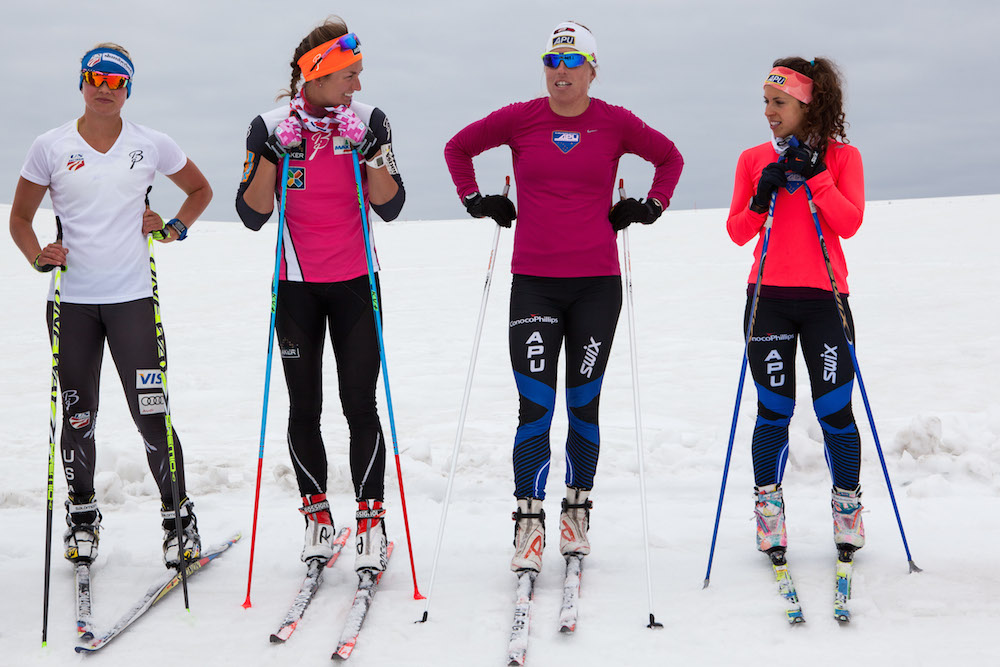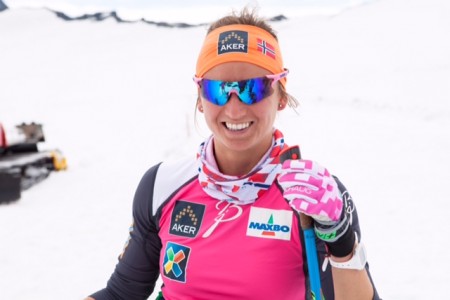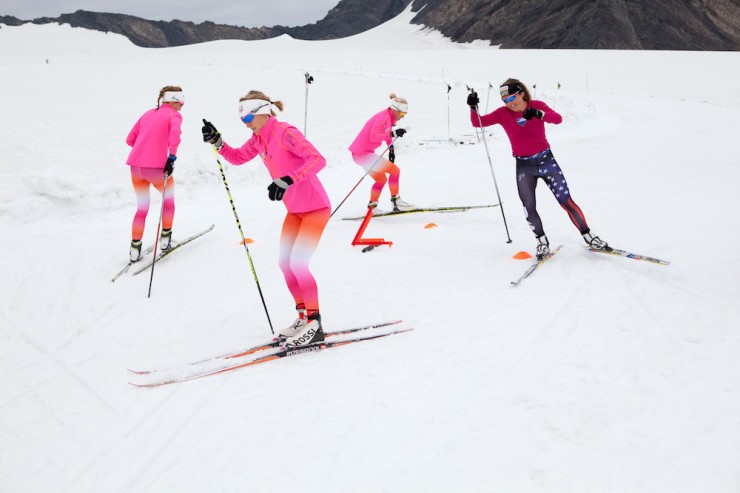
It all started with brown cheese and banana bread. While the U.S. Ski Team was just warming into its five-month World Cup grind, one act of kindness in Beitostølen, Norway, had a lasting effect into the following year.
Last November, Norway’s Celine Brun-Lie visited the U.S. women’s team at their cabin in the village affectionately known at Beito, bringing Scandinavian cheese with her. Then, the group made banana bread.
Eight months later, they were doing more of the same, baking some 4,000 miles away on Eagle Glacier near Anchorage, Alaska.
“It’s amazing,” Brun-Lie, 26, said on the phone last Friday from the glacier. “We are, like, 14 girls and it works really well. The girls are just nice to each other. They want everybody to have a good time. We bake a lot and do nice stuff for each other, so we have good food and everybody’s just smiling.”
As for the Falun-like course: “That’s really cool,” she said of the course with big hills and a technical, curving descent. “[It’s] really, really good training. You have to ski hard uphill and your legs are so tired and you have to ski down. I think it’s really important that you have to do that. It’s just amazing.”In Norway, she said her team will find terrain with similarities to a particular course, but in parts — nothing in its entirety like what APU created.
In the fourth year of the North American Women’s Training Alliance (NAWTA), Brun-Lie, part of Norway’s selective Sochi Olympic team, was invited to be the Americans’ international guest at their Alaska training camp. She’d been to Alaska once before — at least 10 years ago.
But back then, she went with her family on a cruise, visiting what she referred to as tourist spots in places like Juneau. Nothing like what she’d experience in Anchorage.
For two-and-a-half weeks, Brun-Lie explored Anchorage and the Kenai Peninsula, stopping at places like Homer and Seward (for Mount Marathon on July 4) while staying with U.S. Ski Team (USST) member Sadie Bjornsen.
“She is friends with Marine Dusser, my brother’s girlfriend, so I always heard how much fun she was from Marine,” Bjornsen wrote in an email. “Last winter we threw around the idea of her coming to Alaska to visit, and by World Cup Finals she was sold.”
Visiting Alaska had been on Brun-Lie’s mind for the last several years, ever since U.S. women first asked the Norwegian women to come over. Astrid Uhrenholdt Jacobsen joined the camp last July and returned with raving reviews.
“I just asked the girls if I could come and they said yes,” Brun-Lie explained.
Brun-Lie booked her flight in April and took some classes toward her engineering degree at the Norwegian University of Science and Technology in May. With just one stop in Iceland en route from Norway, she arrived in Anchorage with a few days to play before the USST camp.
“We went to all these cool places, doing all these Alaska things, which was really cool,” Brun-Lie explained.
She watched Holly Brooks, Bjornsen’s Alaska Pacific University (APU) teammate, win the prestigious-and-gut-wrenching Mount Marathon hill climb, and later visited Brooks at her cabin in Hope. She took a ride in a bush plane (which she called one of her greatest experiences ever), ate Alaskan salmon (drier than Norwegian salmon, but still good), saw moose, and checked out Anchorage’s abundant recreation and rollerski trails.

After a week of dryland training around Anchorage and another week of on-snow skiing on Eagle Glacier, she spoke excitedly about the camp. Had she been home in Trondheim, Brun-Lie would’ve had the month of July to train by herself.
Instead, she joined a selective group of 14 women in a foreign place. Five belonged to the USST (Bjornsen, Sophie Caldwell, Jessie Diggins, Kikkan Randall, and Liz Stephen), five more came from APU (Brooks, Rosie Brennan, Rosie Frankowski, Becca Rorabaugh, and Lauren Fritz), and three were from other U.S. clubs (Erika Flowers of SMST2, Chelsea Holmes of Sun Valley, and Caitlin Gregg of Team Gregg).
Not only was the trip good for her English (she fielded questions from local reporters at media day on the glacier last Wednesday) , but it was also good for her skiing, Brun-Lie said. A week before the camp, she reviewed the Americans’ two-week training plan with her coaches. It was comparable to what she would’ve done on her own, so she had no problems jumping right in. To her surprise, the U.S. coaches gave her daily feedback.
“I didn’t know if they would care so much about me, but they do,” she said of the camp’s coaches, including APU Head Coach Erik Flora, USST Women’s Coach Matt Whitcomb and USST assistant Jason Cork. “They tell me their ideas and I tell them about mine. It’s really fun to see how similar it actually is. Maybe Matt tells me a little different than something my coaches tell me.”
International Exchange
A sprinter by nature who placed sixth in the classic sprint at the 2010 Olympics, she had been focusing on her stability skills this summer. Last season wasn’t her best, she said.
“I think I was in good shape most of the winter, but I had a tendency to fall in every sprint I did,” she said. “I’m more stable in skating than I am in classic.”
One of eight women to make Norway’s selective 2014 Sochi Olympics team, Brun-Lie had previously claimed two Junior World Championships medals (in 2006 and 2008) and went on to win a Norwegian national skate sprint in 2009. At the pre-Olympics World Cup in Sochi in February 2013, she placed third in the skate sprint.
But she didn’t compete in Russia. Her team was too competitive.
“We have a lot of good skiers; I didn’t race so I didn’t really make the team … I was kind of the reserve,” she said. “It was really tough to know that you were in a dangerous position and you might make the team but maybe not … and then go to the Olympics and be there and really want to race, but I couldn’t race.
“I learned a lot about those two weeks I was there, about myself, about how the team works and everything,” she continued. “It motivates me a lot for next season to not be in that position.”
She was glad to have made the team in the first place, because not making the team would’ve meant she had a bad season, Brun-Lie explained.
“I learned a lot about those two weeks I was there, about myself, about how the team works and everything. It motivates me a lot for next season to not be in that position.” — Celine Brun-Lie, on being ‘on the bubble’ of Norway’s Olympic team
“The hard part this year was that I was good enough to take a medal, but I kept falling in every sprint, and I didn’t know why,” she said. “But just to be there with the girls and … the U.S. Ski Team girls were so nice to me. I got to hang out with them a lot — they took care of me. I was happy to be there.”
“But at the same time we were there to do a job and it was important because we worked on it so long. We learned how the team works and it made us closer than we were before.”Staying in the Olympic village and speaking with athletes from other teams made for “a big family,” she added. “We had amazing coaches and doctors and all the people around us that were doing an amazing job. We got out of it pretty good compared to how tragic it was.”
That kind of relationship prompted her to solidify her trip to Alaska, where she learned more about the U.S. women’s team. Close with her own teammates, especially after the sudden death of Jacobsen’s brother on the eve of the Sochi Olympics, Brun-Lie was especially in awe of the Americans.
“I’ve always been impressed with how they can stay together and have a good time in Europe for five months at a time and not get sick of each other,” she said. “Everybody has their place on the team.”
One thing she noticed was a lack of team-building activities, which they apparently didn’t need during the two-week camp.
“We have a lot of meetings ,” she said of the Norwegian women’s team. “How we want to be with each other … You put kind of the most selfish girls in the country together and we have to work together and it’s amazing it works as well as it does.”
But the Norwegians go home after every World Cup weekend and for some quality alone time, or time with people outside of their team.
“I think it’s amazing how they keep up the good mood and if someone has a bad day, they learn how everyone reacts,” she said. “They learn how to handle it much better than we do. I think we have a lot to learn.”
Bjornsen, 24, explained this year’s camp was one of the best to date — and she trains on Eagle Glacier multiple times a year.
“We do a lot of baking, giggling, recalling stories from our fun times together — and our training is always great,” she wrote. “With 14 girls you can push each other and encourage each other to make one more step forward in training. There is always something to learn from someone else, and someone to follow! I have always loved girls camp.”
As for her team in particular, Bjornsen felt they’re unique because of their different personalities and ability to work together.
“We are all very patient and encouraging of each other which allows us to be individual,” she wrote. “In the summer for example, we are all working on different things. We have different training goals, and different approaches…. yet we are able to come to a camp, work together and have a ton of fun.”
“I think it’s amazing how they keep up the good mood and if someone has a bad day, they learn how everyone reacts. They learn how to handle it much better than we do. I think we have a lot to learn.” — Brun-Lie after getting to know the U.S. women’s nordic team
Bjornsen and Brun-Lie talked a lot about their teams, and ultimately, Bjornsen didn’t think the two were very different.

“They too have tons of fun together, they have good chemistry, good leadership, and a great team,” she wrote. “I think the awe comes from seeing this phenomena in a different place. While we are not doing the ‘exact same thing’, we are finding a way to push each other along in a fun and healthy way! There are so many ways to do this that I think Celine just finds it interesting and exciting.
“I can imagine it would feel the same way for any of the US girls when we join the Swedish Team, or the Norwegian Team, or maybe some others,” she added. “It is a natural thing for woman to bond together — we are just lucky we have some great leadership that has allowed this to happen!!”
Brun-Lie even offered Bjornsen some training tips.
“One day after training, Celine asked if she could tell me something, and she explained what she has been working on and what I was missing a bit,” Bjornsen wrote. “It has been amazing to see how open these girls are, and how we all just want to learn from each other and have a good time together. Training with new buddies, and learning new techniques and ideas keeps things fresh for everyone!”
Six days before flying back to Oslo, before upcoming summer and fall training camps in Norway and Italy, Brun-Lie was already starting to feel nostalgic.
“I was thinking about that, like, ‘Oh no we only have five days left!’ ” she said.
Regardless, she was excited about her own team, with 11 women — the most Norway has had in recent years. In addition to distance skiers, she also has a number of sprinters to work with at home.
Before she left on Tuesday, she extended an invite to her U.S. training partners.
“I hope if they want to come to Norway, they will,” she said. “It’s really nice for the World Cup next year to know them, so if we want to hang out get a coffee, they will.”
Alex Kochon
Alex Kochon (alexkochon@gmail.com) is a former FasterSkier editor and roving reporter who never really lost touch with the nordic scene. A freelance writer, editor, and outdoor-loving mom of two, she lives in northeastern New York and enjoys adventuring in the Adirondacks. She shares her passion for sports and recreation as the co-founder of "Ride On! Mountain Bike Trail Guide" and a sales and content contributor at Curated.com. When she's not skiing or chasing her kids around, Alex assists authors as a production and marketing coordinator for iPub Global Connection.



